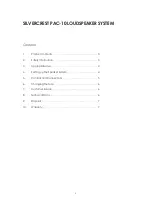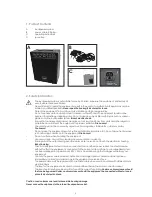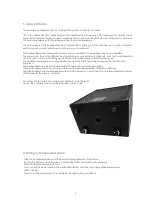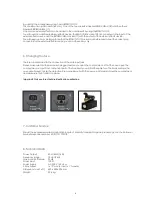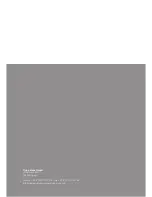
5
5. Controls and Connections
The loudspeaker system has 4 separate channels, labelled CHANNEL 1 to CHANNEL 4.
Each channel has the following controls:
TREBLE (1):
increases or decreases the high frequencies
BASS (2):
increases or decreases the bass frequencies
EFF (3):
mixes the Hall Effect
VOL (11):
volume control for the respective channel
LINE UNBAL (12): jack input for keyboards, acoustic guitars or other musical instruments.
MIC IN BAL (13): XLR input for microphone connection
In addition, there is a 3-Band EQ on the control panel, labelled EQUALIZATION here.
This is used to control the overall acoustic characteristics:
BASS (4):
increases or decreases the bass frequencies
MIDDLE (5):
increases or decreases the medium frequencies
TREBLE (6):
increases or decreases the high frequencies
The POWER switch (7) switches the equipment on and off.
The MASTER (8) controls the overall volume of the loudspeaker system.
The EFF control (9) controls the intensity of the Hall Effect, which can then be mixed on each channel.
A signal from an external music source (e.g. an MP3 player) can be mixed using the CD/TAPE control (10).
The CD/MP3 IN input (16) is located on the rear panel of the loudspeaker system. The connections are illustrated here using the
example of an MP3 player. You will need a Y-cable from a 3.5 mm stereo jack plug on 2x cinch connectors (cable not included
in the product contents):
- Connect the 3.5 mm stereo jack plug to the MP3 player headphone connection.
- The cinch connections are colour-coded (red and white). You can also use the inputs labelled CD/MP3 IN (16).
Connect red to red and white to white.
- Now, you can mix the MP3 player signal using the CD/TAPE control (10).
Caution: Different music sources may have different output sockets.
Other connectors are located on the rear panel of the loudspeaker system:
The power cable supplied is attached to the MAIN INPUT socket (14). The fuse compartment is located below the power cable
socket (see section 2, “Safety Information”).
The individual signals can be edited and recorded with the aid of a recording device connected at the REC OUT socket (15).
CD/MP3 IN (16) has already been detailed in the previous section.
CD/MP3
IN
REC
OUT
R
L
R
L
POWER
PAC-10
BASS
TREBLE
LINE
UNBAL
LINE
UNBAL
LINE
UNBAL
LINE
UNBAL
VOL
VOL
VOL
VOL
MAIN
INPUT
TREBLE
TREBLE
TREBLE
TREBLE
1
1
1
1
5
5
5
5
1
1
1
1
5
5
5
5
0
0
0
0
12
12
0
0
15
15
0
15
15
10
0
10
0
10
0
1
1
1
1
5
5
5
5
1
1
1
1
5
5
5
5
0
0
0
0
BASS
BASS
BASS
BASS
1
1
1
1
0
0
0
0
0
0
0
0
EFF
EFF
EFF
EFF
MIC
IN
BAL
MIC
IN
BAL
MIC
IN
BAL
MIC
IN
BAL
CD/TAPE
EFF
MASTER
EFFECT LOOP
SEND
UNBAL
RETURN
UNBAL
CHANNEL
1
CHANNEL
2
CHANNEL
3
CHANNEL
4
EQUALIZATION
MIDDLE
AC 230V 50Hz
T 1.6A/250V
Speakersystem
54559
WEEE
1 2 3
13 12 11
4 5 6 7
10 9 8
14
15 16
17 18


